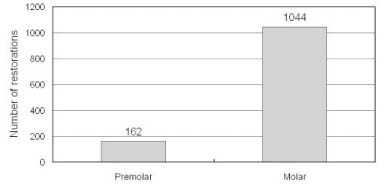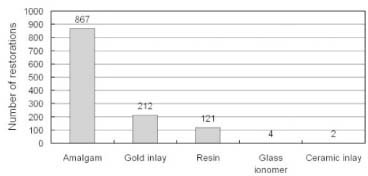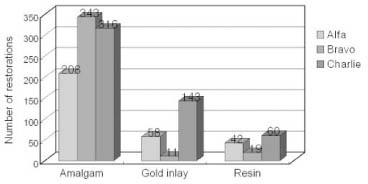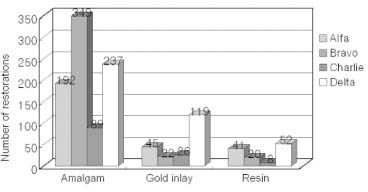Articles
- Page Path
- HOME > Restor Dent Endod > Volume 31(6); 2006 > Article
- Original Article Replacement of posterior restorations
- Ji-Young Kim, Kyoung-Kyu Choi, Sang-Jin Park
-
2006;31(6):-469.
DOI: https://doi.org/10.5395/JKACD.2006.31.6.460
Published online: November 30, 2006
Department of Conservative Dentistry, Division of Dentistry, Graduate School of KyungHee University, Korea.
- Corresponding Author: Sang-Jin Park. Professor of Division of Dentistry, Graduate School of KyungHee University, 1 Hoegi-Dong, Dongdaemun-Gu, Seoul, Korea. Tel: 82-2-958-9335, psangjin@khu.ac.kr
• Received: May 17, 2006 • Revised: September 6, 2006 • Accepted: November 7, 2006
Copyright © 2006 Korean Academy of Conservative Dentistry
- 986 Views
- 2 Download
- 2 Crossref
Abstract
-
This article complies a survey on the replacement of the posterior restorations and accesses possible factors that influence the replacement of posterior restorations.The data was collected from patients that visited department of conservative dentistry from Dec 1st 2003, to Sep 3rd 2004. Teeth was restricted to posterior permanent teeth. 9 dentists recorded age, gender of patients, tooth location, cavity form and restorative material. They rated marginal adaptation, anatomic form, secondary caries of old restoration by modified Ryge criteria system. The statistical analysis was performed with Chi square test (p < 0.05) for replacement ratio according to patients, tooth factor and One-way ANOVA was performed for comparison of old restoration according to restorative material.The results were as follows;1. The female (62%) was statistically higher ratio than the male (38%).2. The distribution of replacement case according to age, the rate of replacement was in descending order, 20's (38.3%), 40's (16.8%), 30's (15.9%), 10's (11.1%), 50's (9.2%), 60's (8.7%).3. The rate of replacement was 88% for molar and 12% for premolar (p < 0.05).4. The rate of replacement was 39% for maxillar and 61% for mandible (p < 0.05).5. The material of restorations was amalgam (69%), gold inlay (17%), composite resin (13%).6. In rating system by modified Ryge criteria system on margin adaptation, there was statistically significant difference between amalgam and gold inlay. But on anatomic form and caries, there was no statistically significant difference among the material of restorations.
- 1. Hickel R, Manhart J. Longevity of restorations in posterior teeth and reasons for failure. J Adhes Dent. 2001;3(1):45-64.PubMed
- 2. Mjör IA. The reasons for replacement and the age of failed restorations in general dental practice. Acta Odontol Scand. 1997;55: 58-63.ArticlePubMed
- 3. Roulet JF. Benefits and disadvantages of tooth coloured alternatives to amalgam. J Dent. 1997;25: 459-473.ArticlePubMed
- 4. Hickel R, Dasch W, Janda R, Tyas M, Anusavice K. New direct restorative materials. Int Dent J. 1998;48: 3-16.ArticlePubMed
- 5. Palotie U, Vehkalahti M. Reasons for replacement and the age of failed restorations in posterior teeth of young Finnish adults. Acta Odontol Scand. 2002;60(6):325-329.ArticlePubMed
- 6. Anderson MH. Current concepts of dental caries and its prevention. Oper Dent. 2001;6(1):11-18.
- 7. Mjor IA. Amalgam and composite resin restorations: longevity and reasons for replacement. 1989;Quintessence Publishing Co Inc; 61-80.
- 8. Allander L, Birkhed D, Bratthall D. Reasons for replacement of class II amalgam restorations in private practice. Swed Dent J. 1990;14: 179-184.PubMed
- 9. Forss H, Widstrom E. Factors influencing the selection of restorative materials in dental care in Finland. J Dent. 1996;24: 257-262.PubMed
- 10. Burke FJ, Cheung SW, Mjör IA, Wilson NH. Restoration longevity and analysis of reasons for the placement and replacement of restorations provided by vocational dental practitioners and their trainers in the United Kingdom. Quintessence Int. 1999;30: 234-242.PubMed
- 11. Mjör IA, Moorhead JE, Dahl JE. Selection of restorative materials in permanent teeth in general dental practice. Acta Odontol Scand. 1999;57(5):257-262.ArticlePubMed
- 12. Deligeorgi V, Mjor IA, Wilson NH. An overview of reasons for the placement and replacement of restorations. Prim Dent Care. 2001;8(1):5-11.ArticlePubMedPDF
- 13. Burke FJ, Wilson NH, Cheung SW, Mjor IA. Influence of patient factors on age of restorations at failure and reasons for their placement and replacement. J Dent. 2001;29(5):317-324.PubMed
- 14. Letzel H, van't Hof MA, Marshall GW, Marshall SJ. The influence of the amalgam alloy on the survival of amalgam restorations: a secondary analysis of multiple controlled clinical trials. J Dent Res. 1997;76: 1787-1798.ArticlePubMedPDF
- 15. Mjör IA. Long term cost of restorative therapy using different materials. Scand J Dent Res. 1992;100: 60-65.ArticlePubMed
- 16. Stoll R, Sieweke M, Pieper K, Stachniss V, Schulte A. Longevity of cast gold inlays and partial crowns-a retrospective study at a dental school clinic. Clin Oral Investig. 1999;3: 100-104.ArticlePubMedPDF
- 17. Ryge G. Clinical criteria. Int Dent J. 1980;30(4):347-358.PubMed
- 18. Ryge G. In: Anusavice KJ, editor. The Californian dental association quality evaluation system: a standard for self-assessment. Quality Evaluation of Dental restorations. 1989;Chicago: Quintessence Pub Co Inc; 273-286.
- 19. Ryge G, Jendresen MD, Glantz PO, Mjor I. Standardization of clinical investigators for studies of restorative materials. Swed Dent J. 1981;5(5-6):235-239.PubMed
- 20. Mjör IA, Moorhead JE, Dahl JE. Reasons for replacement of restorations in permanent teeth in general dental practice. Int Dent J. 2000;50(6):361-366.ArticlePubMed
- 21. Gruythuysen RJ, Kreulen CM, Tobi H, van Amerongen E, Akerboom HB. 15-year evaluation of Class II amalgam restorations. Community Dent Oral Epidemiol. 1996;24: 207-210.PubMed
- 22. Mjör IA, Dahl JE, Moorhead JE. Placement and replacement of restorations in primary teeth. Acta Odontol Scand. 2002;60(1):25-28.ArticlePubMed
- 23. Smales RJ, Webster DA, Leppard PI. Survival predictions of amalgam restorations. J Dent. 1991;19: 272-277.ArticlePubMed
- 24. Plasmans PJ, Creugers NH, Mulder J. Long-term survival of extensive amalgam restorations. J Dent Res. 1998;77: 453-460.ArticlePubMedPDF
- 25. Mjör IA, Shen C, Eliasson ST, Richter S. Placement and replacement of restorations in general dental practice in Iceland. Oper Dent. 2002;27(2):117-123.PubMed
- 26. Hamilton JC, Moffa JP, Ellison JA, Jenkins WA. Marginal fracture not a predictor of longevity for two dental amalgam alloys: a ten-year study. J Prosthet Dent. 1983;50: 200-202.ArticlePubMed
- 27. Osborne JW, Norman RD, Gale EN. A 14-year clinical assessment of 12 amalgam alloys. Quintessence Int. 1991;22: 857-864.PubMed
- 28. Christensen GJ. The coming demise of the cast gold restoration? J Am Dent Assoc. 1996;127: 1233-1236.ArticlePubMed
- 29. Wagner J, Hiller KA, Schmalz G. Long-term clinical performance and longevity of gold alloy vs ceramic partial crown. Clin Oral Investig. 2003;7: 80-85.PubMed
- 30. Hayashi M, Wilson NH, Watts DC. Quality of marginal adaptation evaluation of posterior composites in clinical trials. J Dent Res. 2003;82(1):59-63.ArticlePubMedPDF
REFERENCES
Tables & Figures
REFERENCES
Citations
Citations to this article as recorded by 

- Analysis of the 2-dimensional marginal fit of the occlusal surface and the 3-dimensional accuracy of the inner surface of the occlusal surface according to the inlay prosthesis structure made of composite resin
Kim Dong-Yeon, Lee Tae-Hee, Park Dong-In, Park Jin-Young, Jeong Il-Do, Lee Ha-Na, Kim Ji-Hwan, Kim Woong-Chul
Journal of Korean Acedemy of Dental Technology.2019; 41(1): 21. CrossRef - Repair Rate of Composite Resin Restorations in Permanent First Molar in Children Under 12 Years Old
Yunyeong Jeong, Okhyung Nam, Misun Kim, Hyo-seol Lee, Sungchul Choi
THE JOURNAL OF THE KOREAN ACADEMY OF PEDTATRIC DENTISTRY.2018; 45(3): 370. CrossRef
Replacement of posterior restorations










Figure 1
The distribution of replacement related to gender.
Figure 2
The distribution of replacement related to patient's age.
Figure 3
The distribution of replacement related to tooth designation.
Figure 4
The distribution of replacement related to tooth location.
Figure 5
The distribution of replacement related to cavity preparation.
(O = occlusal cavity, BO, LO = occlusal cavity including buccal or lingual surface, MO, DO, MOD = cavity including proximal surface, CA = cervical cavity)
Figure 6
The distribution of replacement related to material of old restorations.
Figure 7
The marginal adaptation of old restorations.
Figure 8
The anatomic form of old restorations.
Figure 9
The secondary caries of old restorations.
Figure 10
The rating results of old restorations.
Figure 1
Figure 2
Figure 3
Figure 4
Figure 5
Figure 6
Figure 7
Figure 8
Figure 9
Figure 10
Replacement of posterior restorations
Modified Ryge criteria system - Marginal adaptation
Modified Ryge criteria system - Anatomic form, Caries
Table 1
Modified Ryge criteria system - Marginal adaptation
Table 2
Modified Ryge criteria system - Anatomic form, Caries

 KACD
KACD












 ePub Link
ePub Link Cite
Cite

